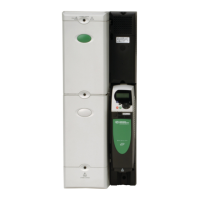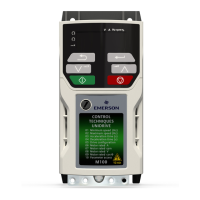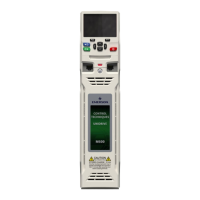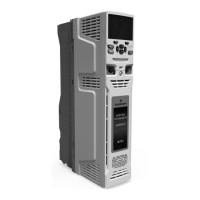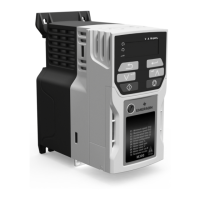Menu 5
Parameter
structure
Keypad and
display
Parameter
x.00
Parameter
description format
Advanced parameter
descriptions
Macros
Serial comms
protocol
Electronic
nameplate
Performance RFC mode
120 Unidrive SP Advanced User Guide
www.controltechniques.com Issue Number: 10
2. Normal low speed test
• The motor is rotated by 2 electrical revolutions (i.e. up to 2 mechanical revolutions) in the forward direction. The drive applies rated current to the
motor during the test and measures the encoder phase angle (Pr 3.25). The phase angle measurement is taken when the motor has stopped at
the end of the test, therefore there must be no load on the motor when it is at rest for the correct angle to be measured.
•Pr 3.25 is saved to EEPROM.
• A stationary test is performed to measure the motor resistance (Pr 5.17).
•Pr 5.17 is saved to EEPROM.
• A stationary test is performed to measure the motor inductance (Pr 5.24). When this test is complete the current loop gains (Pr 4.13 and Pr 4.14)
are over-written with the correct values based on the calculations given in Menu 4. It should be noted that the inductance measured is the
inductance in the flux axis. For many motors this will be 20 to 30% less that the inductance in the other axis. The inductance for the other axis
could be used to calculate the current controller proportional gain if required because there are no transient changes of current reference flux
axis. Therefore the gain can be increased by the user if required. The inductance for the other axis should be used to obtain optimal cross
coupling cancellation (see Pr 5.26 on page 128), and so the inductance parameter (Pr 5.24) could also be increased by the user if required.
•Pr 4.13, Pr 4.14 and Pr 5.24 are saved to EEPROM.
The whole test takes approximately 20 seconds and can be used with motors that take time to settle after the rotor has moved. During the motor
inductance measurement the drive applies current pulses to the motor that produces flux that opposes the flux produced by the magnets. The
maximum current applied is a quarter of rated current (Pr 5.07 or Pr 21.07). This current is unlikely to affect the motor magnets, however, if this level
of current could permanently de-magnetise the magnets the rated current should be set to a lower level for the tests to avoid this.
Either the short or normal low speed tests could be used with a servo motor that does not have an absolute encoder (i.e. incremental without UVW
commutation signals, SINCOS without comms etc). to control a servo motor. A phasing test would need to be performed after each power-up, or loss
of encoder power supply if the motor rotates while the supply is not present before the motor could be controlled by the drive. If this method of control
is used the drive cannot do any error checking to ensure that the absolute position has not been lost due to unwanted encoder counts due to noise.
Either the short or the normal low speed tests can be used with a servo type encoder (Ab.Servo, Fd.Servo or Fr.Servo) that has only commutation
signals, i.e. the lines per revolution has been set to zero. When these tests are performed with this type of encoder the motor will continue to move in
the same direction after the first two electrical revolutions. It will then stop for either 0.8s (short test) or 4s (normal test) and then continue to move
again for part of an electrical revolution.
3: Inertia measurement
See inertia test for closed-loop vector mode. The calculated inertia depends on the value of motor torque per amp entered in Pr 5.32. If this parameter
is incorrect the inertia value will be incorrect. However, as explained in the inertia test description for closed-loop vector mode, this will not affect the
accuracy of automatic speed loop gain set up.
4. Stationary test to set up current controller gains only
• A stationary test is performed to measure the motor resistance (Pr 5.17).
•Pr 5.17 is saved to EEPROM.
• A stationary test is performed to measure the motor inductance (Pr 5.24). When this test is complete the current loop gains (Pr 4.13 and Pr 4.14)
are overwritten with the correct values based on the calculations given in Menu 4.
•Pr 4.13, Pr 4.14 and Pr 5.24 are saved to EEPROM.
This test can only be used with a motor when the correct phasing angle has been set in Pr 3.25, because rated current is applied in the flux axis
during the resistance measurement. If the phasing angle is not correct the motor may move and the results may be incorrect.
5. Minimal movement phasing test
Short current pulses are applied to the motor to produce a small movement and then to move the motor back to the original position. The size and
length of the pulses are gradually increased (up to a maximum of rated current defined by Pr 5.07) until the movement is approximately at the level
defined by Pr 5.38 electrical degrees.. The resulting movements are used to estimate the phase angle. The test is carried out as follows:
• Current pulses are applied to determine the phasing angle
• An additional test is performed to ensure that the phasing angle is correct. If the test fails there is a delay and then test recommences. This is
repeated twice after which a tunE2 trip is initiated. The delay before recommencing the test is 200ms and then 400ms. These delays allow the
motor to stop moving if the test has initiated movement due to cogging torque.
• A test is performed to ensure that the feedback device direction is correct
•Pr 3.25 (phasing angle) is updated and saved to EEPROM.
This test will operate correctly when the load is an inertia, and although a small amount of cogging and stiction is acceptable, this test cannot be used
for a loaded motor. The test can only be used where the total inertia is less than 0.715 x T
rated
/ Pr 5.38 kgm
2
, assuming no additional stictional load,
where Trated is the torque produced by rated current as defined by Pr 5.07 or Pr 21.07. In most cases the motor only moves by the required angle,
however, it is possible for the test to initiate additional movement due to cogging torque. The amount of movement depends on the design of the
motor and is similar to the movement produced by cogging torque when the drive is disabled. If the motor is moving at a speed that is higher than the
zero speed threshold (Pr 3.05) when the test is initiated a tunE3 trip is initiated.
This test can be used with any type of encoder except a commutation only encoder i.e. Ab.Servo, Fd.Servo or Fr.Servo encoders with the lines per
rev set to zero. However, it is also not recommended with Ab.Servo, Fd.Servo or Fr.Servo encoders because the absolute position is not defined until
two valid changes of the commutation signals have occurred after power-up or an encoder trip. Therefore if the test is carried out before two valid
changes have occurred, the movement produced during the test may be quite large and the result may be slightly inaccurate. Once two valid changes
have occurred the test operates in the same way as for other encoder types.
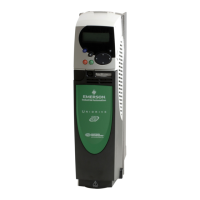
